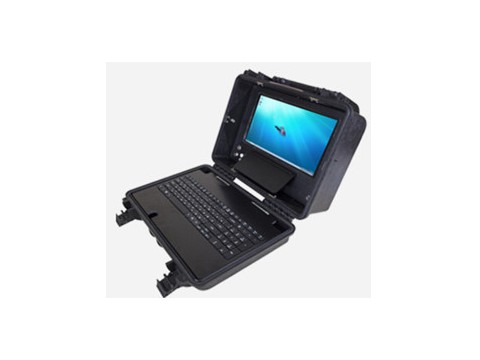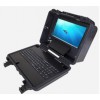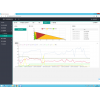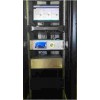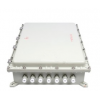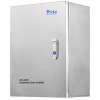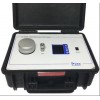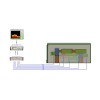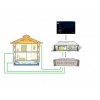Overview:
The Coal Spontaneous Combustion Monitoring System of Duketech is used to monitor the gas content of O2, N2, H2, He,CO, CO2, CH4, C2H4, C2H6, C2H2,H2S,SO2,temperature, pressure, and so on. The regularity of formation of multi-component index gases during spontaneous combustion of coal is detected, which provides technical support and theoretical support for the identification of early hidden danger characteristic information of spontaneous combustion of coal.It can be used as a monitoring system for large-scale coal spontaneous combustion test bench and sample test bench, as well as provides experimental conditions for a multi-direction science such as coal fire prevention and fire science and improves the efficiency of coal mine production.
Principle:
The system analysis host is based on infrared spectroscopy technology, has pulse infrared light source, and forms 10 spectral bands in mid-infrared region through narrow-band optical filter for gas analysis; ultra-high sensitivity patented optical microphone technology with enhanced cantilever beam can be realized through 10 narrow-band optical filters, and ultra-narrow optical filter can remove the interference of background gas; Multi-spectral region can help to minimize the cross sensitivity. It can measure up to 9 kinds of gases at the same time.
Temperature sensor and pressure sensor can be connected to the multi-point sampling unit to measure the sampling gas temperature, air temperature, surface temperature, working temperature and pressure of the multi-point sampling unit.
Advantages:
l High measurement accuracy.
l Low detection limit.
l High-efficiency measurement.
l Easy to carry.
l Lightweight .
l Good reliability.
l Multi-point sampling can be customized.
Features:
l Gases: CO, CO2, CH4, C2H4, C2H6, C2H2, H2O, H2S, SO2, O2,H2,He, N2, temperature, pressure, etc.
l Detection limits of ppb, sub-ppm levels.
l Dust filter, single tube,extraction pump,monitoring computer, spectrum multi-gas sensor, thermal conductivity multi-gas sensor, system software composition.
l Ground data processing and sharing subsystem, including industrial computer, printer, etc.
Functions:
a)The function of using database to analyze the change of gas content in a monitoring point in a period of time;
b)Prediction function of spontaneous combustion fire:by calculating the concentration of each component,alkane-alkene ratio and chain alkenes ratio,timely and accurately reflect the change of fire source temperature;by using triangular rule to discriminate the degree of explosion danger;
C)Historical data query function:system data storage for more than ten years.Provide various data for fire prevention and extinguishing;
d)The functions of report,curve,storage and printing.It can provide daily,monthly,spectrogram graph and gas content trend reports.
e)The functions of automatic alarm of gas concentration exceeding the setting limit,flow display and automatic adjustment.
f)It has the function of networking,realizes the sharing of analysis data,facilitates the leaders and dispatchers to directly detect the changes of underground gas,and can be monitored by APP on the mobile terminal and accessed by remote web pages.
Technical Data:
Response time:
Nine gases<120s
Sampling method:
Extraction type, pumping length is not
less than 1,000 meters;
Measurement range:
CO 0~1% CO2 0~5%
CH4 0~1% C2H4 0~1%
C2H6 0~1% C2H2 0~1%
H2O 0~1% SO2 0~1%
O2 0~25% N2 0~80%
Temperature:(-5-100)℃ Pressure:0~1000KPa
Detection Limit:
CO 1ppm CO2 5ppm
CH4 0.5ppm C2H4 0.5ppm
C2H6 0.5ppm C2H2 0.5ppm
H2O 100ppm SO2 0.5ppm
O2 0.1% N2 0.5%
Temperature and Pressure Resolution:
Temperature:0.5℃ Pressure:0.1KPa
Accuracy:±2% measurement value.
Running time: 24-hour continuous monitoring or manual setting.
Calibration: factory completed and without carrier gas and consumables.
Operating voltage:220VAC@50Hz, power < 100W or 100AH battery.
Standard:
Low Voltage Measurement Directive 2006/95/EC and electro magnetic EMC Directive2004/108/EC EN 50270: 2006, EN 61000-3-2: 2006, EN 61000-3-3: 1995 + A1: 2001 + A2: 2005, EN 61010-1: 2001
Safety standards:
EN61010-1 (2001), IEC 61010-1 (2001), CAN/CSA-C22.2 No. 61010-1 (2004)and UL 61010-1 (2004 incl. rev. 2005)

